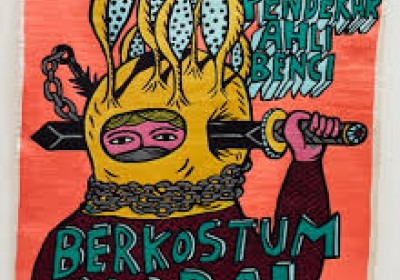Indonesia Art Coalition: Culture Indicator as Development Benchmark
June 21, 2018
Painting by Eko Nugroho
At a glance, the picture looks weird. An unidentified gender individual wearing a maroon costume with turmeric color head cover. Only the person’s eyes are visible. Chains bandaging the person’s neck while the left-hand holds a sword inserted in the ear.
“Wearing the moral costume, waiting for an anti-hatred knight,” writes a caption that explains the caricature created by an artist from Yogyakarta, Eko Nugroho.
Eko’s masterpiece is a social critic toward public attitude nowadays.
As quoted from Brilio.id, the graduate of the Indonesia Institute of the Arts is popular in Indonesia and overseas. Many of his works that tend to be satirical are showcased in some countries, such as Netherland, Australia until the United States. This doesn’t surprise us that Eko is then included in Power 100 A Ranked List of the Contemporary Artworld’s Most Powerful Figures from ArtReview and Icon of the Year 2013 in the Art and Culture by Gatra magazine, Indonesia.
Yogyakarta is known to have produced a lot of best artists and cultural observers in Indonesia. Eko isn’t the only one, others are Butet Kertaradjasa, Martinus Miroto, Diwa Hutomo, and many more who grow in the art city. This is possible thanks to the art ecosystem in Yogyakarta.
“When we wish to develop our arts, we must also grow the art ecosystem,” said Aquino Hayunta, the Program Manager of the Indonesia Art Coalition in June 2018.
Aquiono cited the art ecosystem in batik culture. Batik culture includes an ecosystem comprising of technique, tools, batik artists, technology, and material stock until distributing system. Therefore, Aquiono said, the government must cultivate ecosystem should they wish to preserve the art and culture.
Currently, Aquiono sees there are only three cities that have the strong ecosystem, which is Jakarta, Bandung and Yogyakarta. In Yogya, for instance, the ecosystem doesn’t only cover artists, but also curators, museums or galleries, collectors. The local administration even supports the ecosystem.
Unfortunately, art ecosystem is hard to be found in other regions, especially in the eastern part of Indonesia. Consequently, local culture doesn’t develop optimally. The art and culture can actually help to solve economic gap. South Korea, for instance, is able to reap benefits from its pop culture. One thing for sure, the art ecosystem establishment takes a long time through cultural development.
“In countries whose pop culture can bring in cash, there are the art sectors, like experimental and traditional arts, that are non-profit ones,” Aquino said.
Setting the art ecosystem in regions is one of the innovations to overcome the gap in Indonesia. This is one the solutions to be sought through Indonesia Development Forum 2018. The forum will bring up ‘Pathways to Tackle Regional Disparities Across the Archipelago’ theme. IDF 2018 is initiated by the National Planning and Development Agency or Bappenas and is supported by the Australian Government through Knowledge Sector Initiative. The goal is keeping a sustainable development based on knowledge, experience and fact to support accelerated development in Indonesia to achieve a more equal and more sustainable development.
According to Aquino, culture development is not the type of development that is based on economic indicators, but the welfare and happiness of the humans as the development subjects.
Researcher of the Indonesia Art Coalition Annayu Maharani said the art and culture were actually able to view public expression. People with well-preserved art and culture normally are more open-minded about new things and are willing to discuss discrepancies. The art and culture, Ayu said, was playing an important role to have solved conflicts between Muslims and Christians in Ambon.
“So, we think there should be cultural indicators as the benchmarks of national development, apart from economic indicators,” Annayu said.
Developing, Not Protecting
Annayu said stakeholders must change a paradigm whenever talking about the art and culture. Thus far, the art and culture have been viewed as things that require protection. As a result, culture-related policy tends to preserve and conserve.
“Preserving isn’t enough to answer globalization challenges,” Annayu said.
She said art and culture in Indonesia should be cultivated so as they would be able to compete with other countries’. In fact, the art and culture in Indonesia are well-recognized in overseas. Annayu cited the Indonesian contemporary fine art that became Asia’s second largest. A number of artists often visit other countries to hold exhibitions or even some of their works are bought by international art collectors.
Annayu said the problem regarding the art and culture development in Indonesia was more on supporting system and supporting facilities. This can be solved when art ecosystem develops well.
The Program Manager of Indonesia Art Coalition, Aquiono Hayunta said the art and culture development in Indonesia also required direct support from the government. She cited the support from the United States government for the film.
“When Germany lost in war, the US was negotiating so that their movies could be broadcasted in cinemas in Germany,” she said.
Supports from the government are needed to promote and regenerate the art workers in regions. Aquino gave critics for festival events in regions that were seldom considering the ecosystem sustainability and the new artist regeneration.
“The festivals are good, but should become climax of a series of efforts, researches, information exchange, there are the artists, the education. New works are then displayed at the festivals. Without them, the festivals will solely gather artists who are already popular and only move working places,” Aquino said.
Indonesia’s Research Institutions Supporting the Development of the Electric Vehicle Industry
Indonesian Muslim Fashion and Cosmetics IKMs Shine at Dubai World Expo 2020
Govt Steps Up UMKM Transformation Efforts in the Midst of Pandemic Slowdown
Govt Encourages Promotion of IKM Products in Digital Era
Government Begins Developing Maritime Training Center in Makassar
Tweets by IDDevForum
